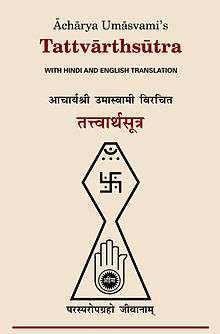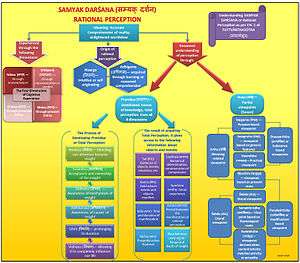Tattvartha Sutra
| Tattvartha Sutra | |
|---|---|
 Tattvartha sutra | |
| Information | |
| Religion | Jainism |
| Author | Umaswami |
| Language | Sanskrit |
| Period | 2nd to 5th century[1][2] |
| Chapters | 10 |
| Sutras | 350 |
| Part of a series on |
| Jainism |
|---|
 |
|
Jain prayers |
|
Ethics |
|
Major sects |
|
Festivals |
|
|
Tattvartha Sutra (also known as Tattvarth-adhigama-sutra) is an ancient Jain text written by Acharya Umaswami, sometime between the 2nd- and 5th-century AD.[3][4][1] It is one of the first Jain scriptures written in the Sanskrit language instead of the Jain liturgical language of Ardha Magadhi.[5] Tattvartha Sutra is also known in Jainism as the Moksha-shastra (Scripture describing the path of liberation).
The Tattvartha Sutra is regarded as one of the earliest, most authoritative books on Jainism, and the only text authoritative in both the Digambara and Śvētāmbara sects (prior to the Saman Suttam). It is a text in sutras or aphorisms, and presents the complete Jain philosophy in 350 sutras over 10 chapters.[6][7] The term Tattvartha is composed of the Sanskrit words tattva which means "reality, truth" and artha which means "nature, meaning", together meaning "nature of reality".[8][9]
One of its sutras, Parasparopagraho Jivanam is the motto of Jainism. Its meaning is interpreted as "(The function) of souls is to help one another",[10] or "Souls render service to one another".[11]
Names
Tattvartha Sutra is also known in Jainism as the Moksha-shastra (Scripture describing the path of liberation).[12][13]
Content
The text written in Sanskrit,[14] begins with an invocation:
I bow to the Lord, the promulgator of the path to liberation, the destroyer of mountains of karmas and the knower of the whole of reality, so that I may realize these qualities.[15]
The first verse of Tattvārthsūtra, "सम्यग्दर्शनज्ञानचारित्राणि मोक्षमार्ग:" summarizes the Jaina path to liberation. It means that the Ratnatraya (three jewels: right view, right knowledge and right conduct) collectively constitutes the path to liberation or moksha.[12][16]
Its ten chapters are:[17]
- Faith and Knowledge
- The Category of the Living
- The Lower World and the Middle World
- The Celestial Beings
- The Category of the Non-Living
- Influx of Karma
- The Five Vows
- Bondage of Karma
- Stoppage and Shedding of Karma
- Liberation

The first chapter deals with the process of cognition and details about different types of knowledge. The next three chapters deal with the Jīva (soul), lower worlds, naraka, and celestial abodes, devas. The fifth chapter discusses the Non-soul (ajīva). The next three chapters deal with the karmas and their manifestations and the influx, asrava, good and bad karma, shubha-ashubha karma and the bondage of the karmas. The ninth chapter describes the blocking, samvara and shedding of the karmas, nirjara. The final chapter discusses moksha or the liberation of the soul.[6]
Seven categories of truth
The theology in Tattvartha Sutra presents seven categories of truth in sutra 1.4:[18]
- Souls exist (Jeeva)
- Non-sentient matter exists (Ajeeva)
- Karmic particles exist that inflow to each soul (Aasrava)
- Karmic particles bind to the soul {which transmigrate with rebirth} (Band)
- Karmic particles inflow can be stopped (Samvar)
- Karmic particles can fall away from soul (Nirjara)
- Complete release of karmic particles leads to liberation from worldly bondage (Moksha)
Umaswami categorizes the types of knowledge to be empirical, attained through one's sense of perception. He adds that knowledge is also acquired through literature, clairvoyance, and omniscience.[19] In chapter 2, Umaswati presents sutras on soul. He asserts that soul is distinguished by suppression of deluding karma, or elimination of eight types of karmas, or partial presence of destructive karmas, or arising of eight types of new karmas, or those that are innate to the soul, or a combination of these.[20] In chapter 3 through 6, Umaswati presents sutras for his first three categories of truth.[21]
Ethics
In chapter 7, Umaswati presents the Jaina vows and explains their value in stopping karmic particle inflow to the soul. The vows, with their respective translations by Nathmal Tatia, are
- ahimsa (abstinence from violence)
- anirta (abstinence from falsehood)
- asteya (abstinence from stealing)
- brahmacharya (abstinence from carnality), and
- aparigraha (abstinence from possessiveness).[22]
Karma and rebirths
Umaswati, in chapter 8 of Tattvartha Sutra explains how karma affects rebirths. He asserts that accumulated karma in life determines the length of life and realm of rebirth for each soul in each of four states – infernal beings, plants and animals, human beings and as gods.[23][24] Further, states Umaswati, karma also affects the body, the shape, the characteristics as well as the status of the soul within the same species, such as Ucchi (upper) or Nicchi (lower) status.[23][24] The accumulated and new karma are material particles, states Umaswati, which stick to the soul and these travel with the soul from one life to the next as bondage, where each ripens.[25][26] Once ripened, the karmic particles fall off, states Umaswati.[25][26]
Shedding karma and liberation
The chapter 9 of Tattvartha Sutra describes how karmic particles can be stopped from attaching to the soul and how these can be shed.[27][28] Umaswati asserts that gupti (curbing activity), dharma (virtues such as forbearance, modesty, purity, truthfulness, self-restraint, austerity, renunciation), contemplation, endurance in hardship (he lists twenty two hardships including hunger, thirst, cold, heat, nakedness, injury, lack of gain, illness, praise, disrespect), and with good character towards others (he lists five – equanimity, reinitiation, non-injury (Ahimsa), slight passion and fair conduct), a soul stops karmic accumulations.[28] External austerities such as fasting, reduced diet and isolated habitation, along with internal austerities such as expiation, reverence, service, renunciation and meditation, according to Umaswati, along with respectful service to teachers and ailing ascetics help shed karma.[28]
The state of liberation is presented in Chapter 10 by Umaswati.[29][30] It is achieved when deluding and obstructive karmas have been destroyed.[29][30] This leads to the state of quietism and potentiality, and the soul then moves to the end of the universe, states Umaswati.[30]
Importance
The Tattvartha Sutra is regarded as one of the earliest, most authoritative book on Jainism, and the only text authoritative in both the Digambara and Śvētāmbara sects,[12].
Commentaries and Translations
Commentaries
The Tattvartha Sutra has the largest number of Jaina bhashyas or commentaries in different Indian languages from the fifth century onward. The total number of commentaries and translations of Tattvartha Sutra goes beyond 25.[14]
The most famous and oldest commentary on the Tattvārthasūtra is Sarvārthasiddhi of Ācārya Pujyapada[31][13] (sixth century CE). Sarvārthasiddhi along with Akalanka's c. 780 CE Rajavartika and Vijayananda's Slokavarttika (9th century) form the central texts of Digambara monastic students.[6]
Translations
The text is in sutra form. The word Sutra (Sanskrit: सूत्र) means "string, thread".[32] The root of the word is siv, that which sews and holds things together.[33][34] In the context of Indian literature, Sutra means a distilled collection of syllables and words, any form or manual of "aphorism, rule, direction" hanging together like threads with which the "teachings of ritual, philosophy, grammar or any field of knowledge" can be woven.[33][32]
The distilled nature of sutra texts leave them open to varying interpretations. The Tattvartha sutra have been variously translated. The first verse of Tattvartha Sutra has been translated as follows, for example:
"The enlightened darsana (world view), enlightened knowledge and enlightened conduct are the path to liberation" – Translated by Nathmal Tatia[35]
"Right faith, right knowledge and right conduct constitute the path to liberation" – Translated by Vijay Jain[16]— Umaswati, Tattvartha Sutra 1.1
The text has been translated into many languages including English and German, latest being English translation in 1993.[14]
See also
Notes
- 1 2 Paul Dundas (2006). Patrick Olivelle, ed. Between the Empires : Society in India 300 BCE to 400 CE. Oxford University Press. pp. 395–396. ISBN 978-0-19-977507-1.
- ↑ Walter Slaje (2008), Śāstrārambha: Inquiries Into the Preamble in Sanskrit, Otto Harrassowitz Verlag, pp. 35 with footnote 23, ISBN 978-3-447-05645-8
- ↑ "Tattvārtha Sūtra". encyclopedia.com.
- ↑ Dundas 2002, p. 86.
- ↑ Vijay K. Jain 2011, p. vi.
- 1 2 3 Jaini 1998, p. 82.
- ↑ K. V. Mardia (1990). The Scientific Foundations of Jainism. Motilal Banarsidass. p. 103. ISBN 978-81-208-0658-0.
Quote: Thus, there is a vast literature available but it seems that Tattvartha Sutra of Umasvati can be regarded as the main philosophical text of the religion and is recognized as authoritative by all Jains."
- ↑ Hemacandra; R. C. C. Fynes (1998). The Lives of the Jain Elders. Oxford University Press. p. xxxix. ISBN 978-0-19-283227-6.
- ↑ Sir Monier Monier-Williams; Ernst Leumann; Carl Cappeller (2002). A Sanskrit-English Dictionary: Etymologically and Philologically Arranged. Motilal Banarsidass. ISBN 978-81-208-3105-6.
- ↑ Vijay K. Jain 2011, p. 72.
- ↑ Umāsvāti 1994, p. 131.
- 1 2 3 Cort 2001, p. 16-17.
- 1 2 S.A. Jain 1992.
- 1 2 3 Natubhai Shah 2004, p. 48.
- ↑ Vijay K. Jain 2011, p. 1.
- 1 2 Vijay K. Jain 2011, p. 2.
- ↑ Vijay K. Jain 2011, p. xi.
- ↑ Umāsvāti 1994, p. xviii-xx, 2-3, 6.
- ↑ Umāsvāti 1994, pp. 12-15.
- ↑ Umāsvāti 1994, pp. 33-62.
- ↑ Umāsvāti 1994, pp. 7-168.
- ↑ Umāsvāti 1994, pp. 169-170.
- 1 2 Umāsvāti 1994, pp. 195-199.
- 1 2 Vijay K. Jain 2011, p. 118-119.
- 1 2 Umāsvāti 1994, pp. 200-203.
- 1 2 Vijay K. Jain 2011, p. 121-124.
- ↑ Umāsvāti 1994, pp. 213-248.
- 1 2 3 Vijay K. Jain 2011, p. 126-145.
- 1 2 Umāsvāti 1994, pp. 250-263.
- 1 2 3 Vijay K. Jain 2011, p. 146-151.
- ↑ Banerjee, Satya Ranjan (2005). Prolegomena to Prakritica et Jainica. p. 151.
- 1 2 M Winternitz (2010 Reprint), A History of Indian Literature, Volume 1, Motilal Banarsidass, ISBN 978-8120802643, pages 249
- 1 2 Monier Williams, Sanskrit English Dictionary, Oxford University Press, Entry for Sutra, page 1241
- ↑ MacGregor, Geddes (1989). Dictionary of Religion and Philosophy (1st ed.). New York: Paragon House. ISBN 1557780196.
- ↑ Umāsvāti 1994, pp. 5-6.
References
- Cort, John E. (2001), Jains in the World : Religious Values and Ideology in India, Oxford University Press, ISBN 0-19-513234-3
- Dasti, Matthew R.; Bryant, Edwin F., eds. (2014), Free Will, Agency, and Selfhood in Indian Philosophy, Oxford University Press, ISBN 978-0-19-992274-1
- Dundas, Paul (2002) [1992], The Jains (Second ed.), London and New York: Routledge, ISBN 0-415-26605-X
- Jain, Prof. S.A. (1992) [First edition 1960], Reality (English Translation of Srimat Pujyapadacharya's Sarvarthasiddhi) (Second ed.), Jwalamalini Trust,

- Jain, Vijay K. (2011), Acharya Umasvami's Tattvarthsutra (1st ed.), Uttarakhand: Vikalp Printers, ISBN 81-903639-2-1,

- Jaini, Padmanabh S. (1998) [1979], The Jaina Path of Purification, Delhi: Motilal Banarsidass, ISBN 81-208-1578-5
- Jones, Constance; Ryan, James D. (2007), Encyclopedia of Hinduism, Infobase Publishing, ISBN 978-0816054589
- Oldmeadow, Harry, ed. (2007), Light from the East: Eastern Wisdom for the Modern West, World Wisodm, ISBN 978-1-933316-22-2
- Shah, Natubhai (2004) [First published in 1998], Jainism: The World of Conquerors, I, Motilal Banarsidass, ISBN 81-208-1938-1
- Umāsvāti, Umaswami (1994), That which is (Translator: Nathmal Tatia), Rowman & Littlefield, ISBN 978-0-06-068985-8
Further reading
- Umāsvāti; Devanandī; Siddhasenagaṇi (1994). Nathmal Tatia, ed. That which is: Tattvārtha Sūtra. Rowman & Littlefield. ISBN 978-0-06-068985-8. Retrieved 27 December 2012.
